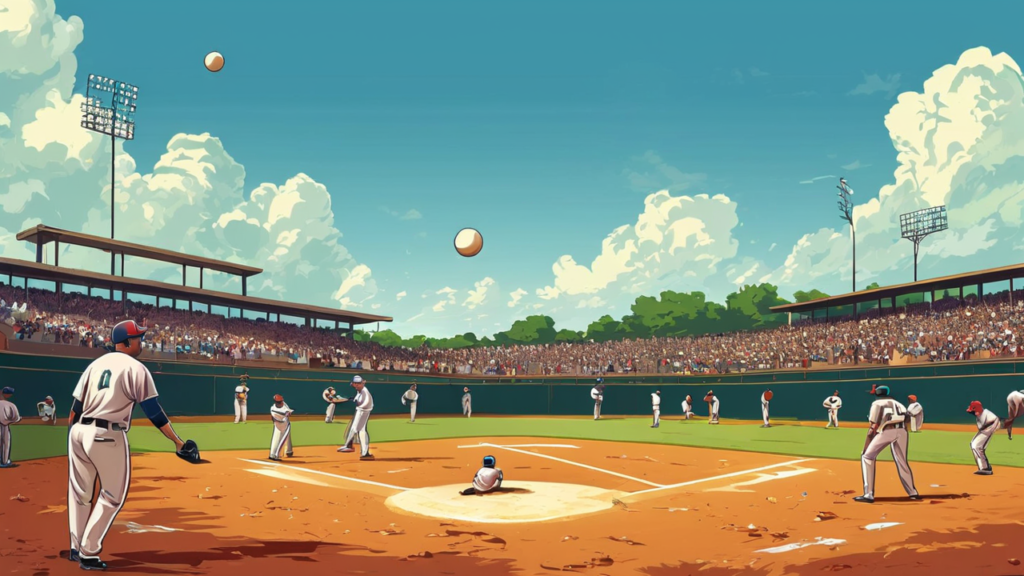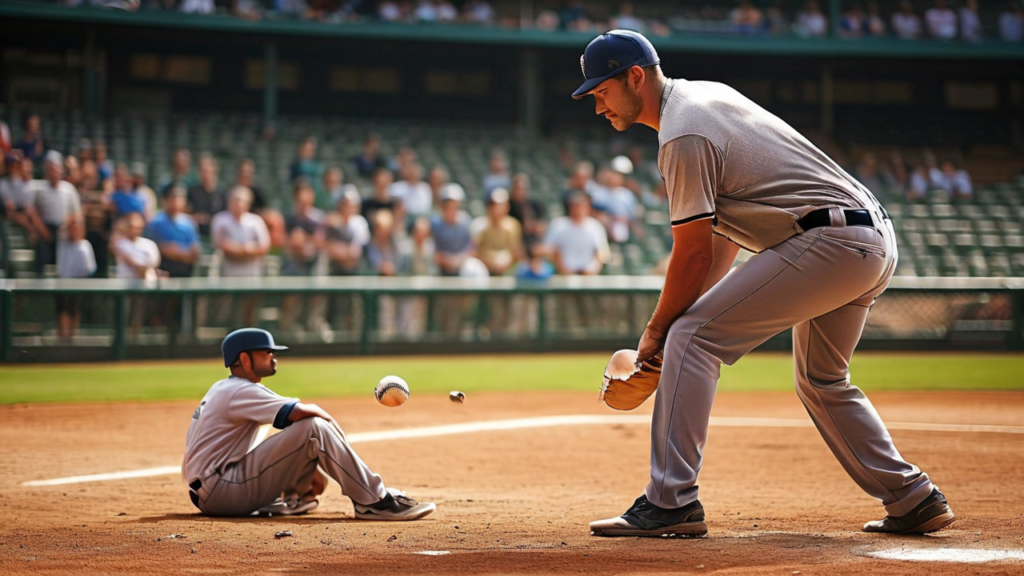If you want to know how to play baseball, you must understand some basics about the game. In this guide, we will teach you the fundamental knowledge you need in a very easy and smooth way. If you can spare a few minutes, we hope you will learn every major aspect of baseball. Let’s start now!
Overview of Baseball
Baseball is a wonderful game that involves three key actions: throwing, hitting, and catching. The professional game is usually composed of nine innings, where the team with the highest runs is declared the winner. Each inning is divided into two halves. The visiting team (offensive players) bats in the first half of the inning, and the home team (defensive players) bats in the second half. If both teams score the same number of runs, they play extra innings until one team wins.
Basic Equipment Needed
If you want to play baseball, you need the following basic equipment:
- Baseball
- Baseball bat
- Gloves
- Protective helmets
- Bases
A baseball game is played between two teams consisting of nine players on a baseball field, usually referred to as a diamond.
Structure of the Baseball Field

The baseball field is divided into two regions: the infield and the outfield. The infield consists of four bases, while the outfield is behind the bases from the home plate. There are two territories named foul territory and fair territory. Foul territory is outside the foul lines set on the left and right sides of the home plate. Fair territory is the area inside the foul lines, consisting of both the infield and outfield. When the batter hits the ball with a bat, and the ball flies between these foul lines, it is called a fair ball.
Bases Position and Their Distances
There are four bases on a baseball diamond, forming a diamond shape that starts from the home plate. The home plate is the starting base that the batter must touch to score. The other three bases are first base, second base, and third base, with the shortstop positioned between the second and third bases. These bases are 90 feet apart in a professional baseball field.
The first base is on the right side of the field, the second base is at the top of the infield, the third base is on the left side, and the shortstop is between second and third bases. The batter must run around the infield, touching these four bases to score a run.
These are the fundamental aspects of the baseball field that must be understood before playing.
Mechanism of the Game
Now let’s take a closer look at the mechanics of the game.
Umpires: Their Positions and Duties
There are four umpires who judge the rules and regulations of the game and make decisions. One umpire works behind home plate, while the other three are positioned at the bases. The home plate umpire stays behind home plate, rotating clockwise for the next game.
The home plate umpire is responsible for calling balls and strikes. The other umpires call fair or foul, safe or out from their own zones. Other decisions, like ejections, timeouts, and balks, can be made by any of the umpires on the field.
Players and Team Roles
A baseball game consists of two teams, each with nine players. These two teams are called the offensive team (also known as the batting team or visiting team) and the defensive team (also known as the fielding team or home team).
- Offensive Team: This team always bats to score runs.
- Defensive Team: This team always fields the ball.
Main Focus of Playing Baseball
The focus of the baseball game is on:
- The Pitcher: The defensive player whose main objective is to pitch the ball to the catcher without giving the batter a chance to hit it. The pitcher starts the game by throwing the ball toward home plate. The rules for this are referred to as the Knickerbocker Rules, a set of baseball rules established in 1845.
- The Batter: The offensive player whose primary objective is to hit the pitched ball and score runs.
Pitcher’s Mound
The pitcher’s mound is a key component of playing baseball. It is a white rubber slab, commonly known as the pitcher’s mound or pitcher’s plate. The mound is 6 inches high and 2 feet wide (61 inches). The pitcher usually stands on this dirt mound and throws the ball to the batter, who stands on home plate.
Batter’s Boxes
Under the rules mentioned earlier, batters have specific areas for batting called batter boxes. There are two batter boxes, one on each side of home plate. Both batter boxes are the same size, measuring 6 feet long and 4 feet wide. The batter boxes are centered on home plate with inside lines.
The batter stands on home plate, facing the pitcher to hit the ball with a swinging bat. Before the game starts, the batting team chooses its lineup, which is a special order for the batters. This lineup cannot be changed after the inning begins. A new player can be substituted for the original one. After a batter is out, the next batter comes to the field and tries to hit the ball thrown by the pitcher. The batting team always aims to score runs.
To score a run, a player must hit the ball and become a base runner without being called out. A base runner is a player who touches all the bases in order and reaches home plate last without being out by the defensive team. After the ninth player in the batting lineup bats, the first player starts again. A player can score only one run each time they bat.
The fielding team works to prevent the batter from hitting the ball or scoring runs. The defense consists of seven fielders, along with a pitcher and a catcher. The pitcher throws the ball to the catcher, aiming to make the batter out. The catcher stands behind home plate to catch any balls the batter misses.
Types of Baseball Bats
If you want to know what types of baseball bats to use while playing, the answer is that there are various types of bats for different age levels and categories. These include wood bats, aluminum bats, composite bats, and hybrid bats. In Major League Baseball (MLB), players primarily use BBCOR-certified bats, though players at different age levels may also use wood bats and other types.
Infielders: Positioning in the Game
If you want to know how to organize the players in the field, here are the positions of the four infielders:
- First Baseman: This player’s job is to field the area near first base, which is crucial for preventing runs. The defensive team typically assigns their best player to this position.
- Second Baseman: This player fields the area between first and second base. Quick reflexes are essential in this position.
- Shortstop: The shortstop stands between third base and second base in the infield. This player must field the ball cleanly and throw it to second base to stop runs.
- Third Baseman: The third baseman is responsible for defending third base. A runner must touch this base to complete a run, making this position very important.
Outfielders: Their Roles

In modern baseball, outfielders play a significant role in defense. The three outfielders are:
- Left Fielder: Stands behind the third baseman and shortstop on the left side of the outfield.
- Center Fielder: Positioned behind second base, the center fielder covers the central part of the diamond.
- Right Fielder: Stands behind first and second bases, which is crucial since many balls are hit to this area.
The fielding team can shift their fielders at any time, depending on the type of batter. The defensive team’s goal is to prevent the batter from getting hits or scoring runs by applying various defensive strategies. Batters must keep their eyes on the ball to determine where to hit it.
Different Types of Outs
There are several ways to get a batter out. To understand how to play baseball, you must be familiar with the types of outs:
- Strikeout: When a batter accumulates three strikes during their at-bat, it’s called a strikeout. Strikes depend on where the pitch ends up in the strike zone and how the batter responds. A strikeout occurs when three successive pitches are not hit by the batter.
- Fly Out: If a fair fly ball is caught by any infielder, pitcher, catcher, or outfielder with runners on first, second, or third base and no more than one out, it’s called a fly out.
- Tag Out: A tag out occurs when a base runner running toward a base is tagged by a fielder with the ball. This can be done by the first, second, or third base fielder, as long as the ball is live and the runner has not touched any of the bases.
- Force Out: A force out occurs when a base runner is forced to leave their base, allowing a fielder to tag the runner before they reach the next base. This is similar to a tag out.
These are common types of outs that can happen in baseball. There are other less frequent outs, but they are not as common.
After recording three outs, half of the inning is finished. The two teams then switch positions, with the batting team playing defense and the defensive team coming up to bat. The winning team is determined after nine innings. If the game is tied, additional innings will be played until a winner is declared.
Conclusion
These are the most basic tips to know how to play baseball. If you want to explore more guides about baseball,


